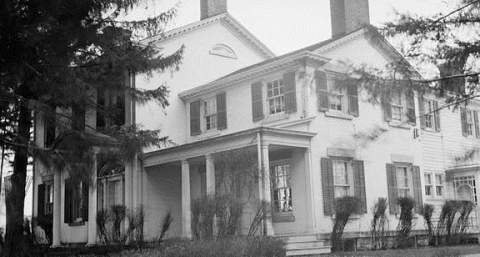Around 3500 B.C., Native Americans were the first to make their home in the area that would become Cayuga County, settling on the banks of Cayuga Lake. By 1000 A.D., the descendants of the first inhabitants had developed agriculture, a practice they supplemented with hunting and gathering. When Europeans arrived in the area in the late 18th century, the land was populated by the Cayuga tribe, one of the five nations of the Iroquois Confederacy. Their tribal center at Goiogouen was destroyed by fire in 1779 during the infamous Sullivan Campaign, which targeted Iroquois communities across the state with the intention of destroying the Confederacy's military prowess. Many of the surviving Cayuga people fled to Ohio, and later to Oklahoma, where their descendants formed the Seneca-Cayuga Tribe of Oklahoma.
The first European settler in Cayuga County was Roswell Franklin, who lived near present-day Aurora. A portion of the county was divided and granted as bounty payments to Revolutionary war soldiers, many of whom eventually sold the land, as it was of low quality. Most of the land in Cayuga County, however, is exceptionally arable, as evidenced by the fact that it has supported a wide range of agricultural activities for over a thousand years. During the 19th century, the most common crops raised in Cayuga County were hops, tobacco, and sugar beets. Today, dairy, wheat, corn, and apples dominate the farming industry.
Present-day Cayuga County was formed in 1799 when it was split from Onondaga County. By 1800, its population was more than 15,000. The construction of the Erie Canal accelerated the influx of settlers, particularly in the eastern portion of the county. In 1834, the foundation of the Auburn and Syracuse Railroad further facilitated transportation between Cayuga and other areas of the state. Around the same time, Cayuga became a thriving industrial center, with factories producing shoes, carpets, rope, trains, and air conditioners.
If you are looking for records in Cayuga County, a must see resource is the Cayuga County Records Management. Their holdings include military records (Revolutionary and Civil Wars), census records 1800–1925, maps and atlases, marriage records 1908–1936, naturalization records 1799–1952, property assessments 1840–1985, and surrogate’s court records 1799–2003. A complete list of holdings can be found in the Records Archives section on their website: http://www.cayugacounty.us/Departments/Records-Retention/Records-Archives
While you are in Cayuga County, try checking out the Cayuga-Owasco Lakes Historical Society (COLHS). The Society focuses on the southeastern towns of Cayuga County, and President Millard Fillmore who was born in Moravia. Holdings include atlases and maps, Bible records, books and gazetteers, cemetery records (267 cemeteries), census information (including 1828 Quaker census), church information and booklets, family files, newspaper abstracts 1819–1865, photographs and scrapbooks, town histories, and several vital records indexes. A complete list of holdings can be found on the Society’s website, along with a list of surnames featured in its family files at http://www.colhs.org/
NYG&B members enjoy access to all our original county guides on our website. Each guide was created by experts in the field in order to direct researchers to these local, unique resources. To learn more about the benefits of membership, see our membership page HERE.
Good luck with your research!
